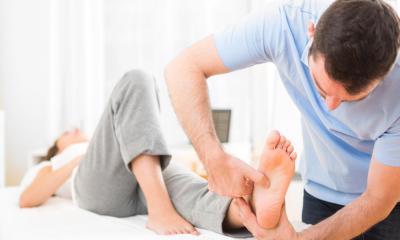
Reflexology is one of the most popular of the complementary alternative therapies. Read our in-depth practical guide to starting up and running your own reflexology practice.
- Research your target market
- Establish your client profile
- Complementary medicine
- Pricing policy
- Promote your business
- Buy an existing business
Research your target market
Estimating demand
It's very important to find out whether there's enough demand in your area for the reflexology practice you're planning. Although complementary medicine has become very popular with clients you will be competing against:
- other reflexology practices
- other therapists offering different types of treatment for the same range of conditions that reflexology can help. For example, clients might visit an aromatherapist or an acupuncturist
A look on Yell.com will give you an idea of how many reflexologists and other complementary therapists are already practising in your area.
You could also use the practitioner search tool on the Complementary & Natural Healthcare Council (CNHC) website to check the number of therapists in your area, although bear in mind that registration is not compulsory so the directory may not give you the full picture.
It may be that you will only be competing against a few of of these practitioners because you will be concentrating on helping people with certain problems, such as migraines or hormonal problems.
Have a good look at existing reflexology practices to establish:
- what qualifications and training the therapist has. At present anyone can set up as a reflexologist without any formal qualifications but clients will be reassured of your competence if you are a member of a reputable professional association such as the Association of Reflexologists (AOR), hold a recognised qualification and are registered with either the General Regulatory Council for Complementary Therapies or the Complementary and Natural Healthcare Council
- the range of conditions they treat
- if they specialise in a particular type of client
- how much they charge
- whether the consulting rooms are hygienic and smart
- what other therapies they offer, if any
Working alongside GPs and other health professionals
The use of complementary and alternative medicine, including reflexology, has increased considerably in recent years and many GPs are prepared to refer patients to therapists for treatment if they feel it would help them. You might consider approaching your local hospitals and doctors to see if there would be opportunities for you to provide reflexology services to patients under the NHS. If not, GPs might be prepared to refer patients to you - patients would then pay for the treatment themselves or possibly may be covered by a health insurance policy.
Other opportunities
You might be able to come to an arrangement with businesses such as health spas or fitness centres whereby you provide treatment at their premises, say, one or two days each week. You would benefit from having a broader client base, and the other business would benefit by being able to offer clients a wider range of services in-house.
Other organisations that you might consider approaching include:
- hospices
- residential care homes
- large companies that want to provide stress-relieving therapies for their staff
- hotels
Research current trends, plus legal and tax issues
Establish your client profile
Your market
Although you are likely to have some male clients, it appears that reflexology is most popular among females, particularly younger, professional women. Some of your clients will have their fees covered by health insurance (with or without a GP referral) but most of them will be paying for their treatment themselves.
Consultations
The initial consultation with a client may last for about 90 minutes, during which time you will ask the client about his or her lifestyle and the nature of the complaint for which they are seeking help. This will give you the information you need to draw up a treatment plan for the client. In most cases several sessions will be needed in order for the client to obtain the maximum benefit - for example, between three or six appointments. These are usually shorter than the initial consultation, lasting between 45 and 60 minutes.
You may be prepared to make home visits, especially if your clients have difficulty in getting to your consulting rooms. It might be worth offering evening and weekend sessions to appeal to full-time workers.
Collecting payment
Give some thought to when you'll aim to collect payment from your clients. For example you might decide to ask for your fees at the end of each session. Some therapists offer a discount if a few sessions are pre-booked and paid for up-front.
Complementary medicine
Complementary and alternative medicine (CAM) covers a large number of different therapies, which work holistically by balancing a patient's physical, emotional and spiritual state. The most established disciplines are acupuncture, herbalism, homeopathy, chiropractic and osteopathy, although reflexology has become increasingly popular in recent years. You might decide to offer several therapies in addition to reflexology - you may have the training and expertise to offer these yourself or you may engage the services of other practitioners. A brief description of some CAM therapies is included below:
Reflexology
Reflexology is thought to have been practised in ancient Egypt, but the science of reflexology practised today was developed in the 1920s by an American ear, nose and throat surgeon, Dr. William Fitzgerald. He divided the body into 10 equal zones, ending in the hands and feet - for this reason reflexology is sometimes also called zone therapy. Dr. Fitzgerald's approach was later refined by Eunice Ingham and the treatment became known as reflexology. The therapy is based on the observation that tension in any part of the foot corresponds to tension or congestion in a related part of the body. Massage techniques are used to stimulate reflexes on the feet which then create changes in other parts of the body which help to restore health, overcome illness and correct imbalances in the body. It is used to treat a range of problems and complaints including stress-related conditions, hormonal problems, muscular pains, sports injuries, arthritis and headaches. It promotes relaxation and well-being and can be used to treat patients of all ages.
Aromatherapy
Aromatherapy uses essential oils extracted from plants to treat a range of conditions such as stress, depression, hypertension, rheumatism, muscular strains, asthma and so on. There are over 400 different oils and the therapist will decide on which are the most appropriate to use for the client's individual complaint. Generally three or four oils are selected and, because they are very potent, only a few drops are used, diluted in a carrier oil such as jojoba, almond or grape seed oil. Therapy involves massaging the client with the oils, which is the most common method, but they can also be inhaled or applied as a cold compress. Aromatherapy should not be used on pregnant or breast feeding women or people with epilepsy.
Acupuncture
Acupuncture originated in China some 3,000 years ago and involves inserting very fine stainless steel needles into particular points on the body to stimulate nerve impulses. Traditional Chinese medicine is based on the concept of vital energy (or qi which flows around the body along invisible channels (or meridians). Well being is achieved by regulating the flow of energy and correcting any imbalances by inserting the needles at specific points on the body.
Western acupuncture uses the same needling techniques but affects nerve impulses and the central nervous system. Acupuncture is used to treat a wide range of ailments and conditions, including back and neck pain, osteo-arthritis, allergies, pain relief and smoking cessation.
Osteopathy
Osteopathy is a system of diagnosis and treatment, primarily for musculo-skeletal problems. Treatment consists of manipulation to correct the underlying causes of the pain - this may include massage, stretching and other exercises.
Chiropractic
Chiropractic treats musculo-skeletal disorders by manipulating and massaging the muscles, joints and ligaments of the body to put right any dysfunction of the spine and pelvis.
Herbal medicine
Herbal medicine uses remedies produced from plants to both treat complaints and to maintain good health.
Homeopathy
Homeopathic treatment uses very small doses of substances that, if taken in high doses by a healthy person, would produce the symptoms that the remedies are designed to treat. It is based on treating "like with like".
Other complementary therapies include:
- hypnotherapy
- Alexander technique
- Shiatsu massage
- yoga
- healing
- Traditional Chinese Medicine (TCM) which includes acupuncture, herbal medicine, massage and the exercise technique called Qigong
- naturopathy
- meditation
- nutritional medicine
and many others.
Pricing policy
Getting your fees right is very important. You must make sure that they cover all of your operating costs, including your own drawings. Don't forget to keep a note of your travelling expenses if you make home visits - its easy to overlook the cost of providing this type of service.
It is common to offer clients an initial consultation that is longer than any subsequent treatments and this might be charged at around £45 for a 90 minute session. The follow-up, shorter sessions might typically be charged at between £30 and £35 and last for an hour or so. Some therapists make an extra charge for the oils and creams used during a treatment. You might have some regular clients who come once a month for 'maintenance' treatments - you might offer this type of client a lower price or one free treatment after a certain number of full price treatments have been taken.
Think about whether you will offer any other discounts - for example to students, pregnant women or elderly people, or if clients book, say, six or 12 treatments. You might want to consider your policy with regard to cancelled appointments - some practitioners charge the full fee if the client cancels at the last minute.
Depending on the range of therapies your practice offers, you might decide to offer various packages. For example you might offer a two or three hour session that includes a reflexology treatment, a body massage and a facial. You would charge less for the package than if the client took each treatment separately.
As part of your market research it makes sense to check out the fees charged by existing reflexologists in your area and it's likely that you'll set your own fees more or less in line with theirs. Many therapists include details of their fees on their websites - this will help you build up a picture of what you should charge.
If you plan to regularly offer a discount from your normal tariff it's a good idea to keep comprehensive details of this - it will be helpful if HM Revenue & Customs ever investigate your business.
Promote your business
It makes good sense to give some thought to how your potential clients will know about your reflexology practice. This is particularly important if you are planning to work from home and won't be visible to passersby. Ideally you will have consulting rooms in a complementary medicine centre where you will benefit from being noticed by clients who are visiting other therapists.
There are a number of things you can do to promote your practice:
- contact GPs, physiotherapists, hospices and hospitals to see if there are opportunities to offer reflexology to their patients
- set up your own website giving details of the treatment you offer, the price and how reflexology can help people suffering from certain conditions. Don't forget to include details of your qualifications and professional status to reassure clients that you practise to a high standard
- leave promotional leaflets with as many outlets as possible such as sports centres, pharmacies, health clubs and so on
- sell gift vouchers that clients can give as presents - these will bring new customers to you
- write articles on the benefits of reflexology for your local newspaper. You could offer attractive discounts to readers who pre-book a few sessions
- become a member of a professional association and benefit from inclusion in an online Directory that members of the public can search
- apply for admission to the General Regulatory Council for Complementary Therapists (GRCCT) register or the Complementary and Natural Healthcare Council (CNHC) register. Both the GRCCT and CNHC websites have a Find a Reflexologist feature
- use social media like Facebook or Twitter to tell potential clients about your practice
- start a reflexology blog to share information - for example about latest research findings supporting the use of reflexology in treating different conditions
Buy an existing business
You might decide to buy an existing reflexology practice rather than start your own venture from scratch. Buying a going concern can mean that the products, customers, regular sales, staff, premises and equipment are already in place.
But buying a business can be a hazardous, expensive process unless you have the right skills and experience on your team, including legal and financial know-how. Establish the genuine trading and financial position, so that the price you pay for the business is not too high.



